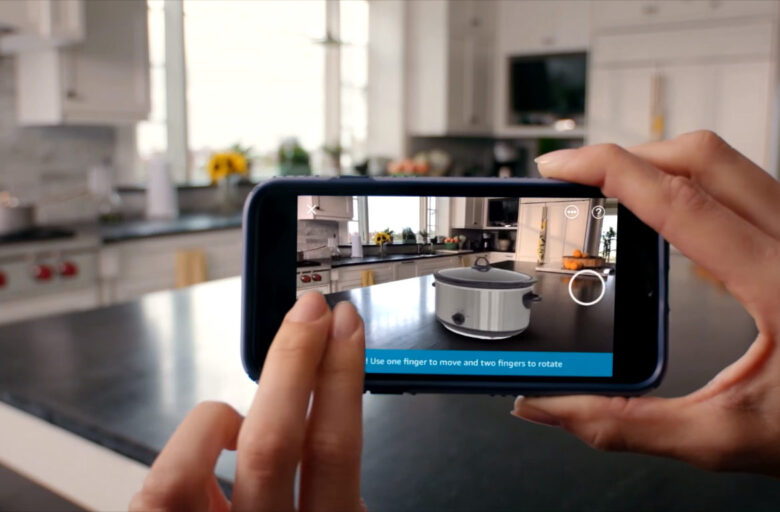With passing time, visual eCommerce has successfully altered the expectations of customers regarding online shopping. The noteworthy thing is eCommerce utilizes 3D visuals and AR or augmented reality that is embedded on the mobile applications and website pages for providing customers a highly interactive and graphical representation of products. Customers can get various engaging interactions from online product configurators.
They can browse as well as have interaction with products via swipe, touch, or dragging products all across touchscreens. A few innovative retailers have begun to deploy 3D applications and AR in their brick-and-mortar stores too. Again, many retailers of eCommerce have engaged themselves in embracing 3D and AR technology for boosting the engagement of customers, escalating sales, and also surpassing their competitors.
There are many factors that make AR or 3D technology turn into a compelling power in online retail. Nonetheless, they all get to only one factor, and that is “customers.” The customers of today wish to get convenience and choice and they habitually want entertainment. Again, at times, they even wish to create a deep relationship with the brand. And so, immersive or visual eCommerceis capable of bringing all these impacts to the customers.
According to a report, highly engaged customers spend nearly 60 percent more time on every transaction and also purchase 90 percent frequently. Due to this engagement, AR and 3D are integral for online retail. Regardless of where you prefer to host your store, like on Salesforce, WooCommerce, Magento, SAP, Shopify, or any other platform you must follow some fundamentals for AR and 3D for eCommerce:
A digital roadmap

Source: griddynamics.com
AR in eCommerce has got several distribution points and it produces limitless opportunities to augment the customers’ purchasing journey. Regardless of whether you have been starting with social commerce through 3-dimensional acts on Facebook or utilizing AR and 3D on your eCommerce site, it is vital for you to possess a roadmap. From the strategic point of view, you will come across various moving parts and they begin from 3-dimensional creative to execution, optimization programs to testing, that get managed internally or through a technology partner.
To recognize the ideal distribution channel that makes proper sense for a business, you must start with your aims. You need to know whether your interest lies in branding lift, refining engagement or just buying intent. When you wish to have improved conversion then you must take into consideration more AR and 3D product experiences on the product pages of your eCommerce directly.
Among the many challenges of 3-dimensional content, production happens to be scale. 3D does form a critical groundwork and from here, you can form limitless various experiences that address the needs of the buyers in novice methods. Provided the variety of product categories as well as unique SKUs that are delivered to customers, it becomes critical to form tools and processes that showcase and systematize 3-dimensional content in the best possible manner.
2-dimensional models

Source: rootinfosol.com
Both the experiences of AR and 3D require superior quality 3-dimensional product models. It is important for these models to be formed, and also optimized for app or web and that too in various file formats based on distribution. However, the important thing is these models must be updated with probable technology and product updates and they are also required to be accessible for both deploying and previewing.
There are various methods of 3-dimensional asset creation, like laser scanning, 3-dimensional modeling, and photogrammetry. A business having internal creative teams might have made this out. An extensive and imaginative pipeline is important to any AR or 3D approach as in its absence, businesses might get bogged down fast and that too with a 3D asset workload.
Competent 3D artists

Source: ecommercegermany.com
When the matter comes to AR then having appropriate 3D product models tends to be important because the reasonableness of the experience happens to be genuine similar to the models that people utilize. It is particularly important for the brands of eCommerce that hope the 3D models to be typical of their physical products’ quality.
The requirement for the accuracy of 3-dimensional product models does extend to every retailer and brand and it is hugely dependent on having entrée to some excellent 3-dimensional artists. For an online retailer, visualization is hugely important. A shopper is required to understand how an item that they see in-store or online would fit and look in their original space before they make a buying decision. For forming this experience and also bridging the gap between digital and physical worlds, it becomes important for a person to utilize high-fidelity and precise product imagery and it includes 3-dimensional models. You must also remember that the best artists can only create the finest models.
No matter through external or internal partners, eCommerce businesses must concentrate on forming a 3-dimensional artist pipeline that scales for delivering 1st class 3-dimensional assets for countless SKUs that are optimized for many channels and formats.
Unified site integration

Source: g2.com
Though incorporating 3-dimensional models on the site might seem very simple as including some lines of JavaScript only, this is the case with an effectual platform approach that comprises hosting as well as fast delivery of the 3-dimensional models to an iFrame at a time when they are called.
Based on the version of Google, 53 percent of mobile site visitors do abandon a page that takes longer than three seconds for getting loaded. Immersive eCommerce is highly effective and a scalable combination of AR and 3D is significant for a web page to remain fast. When you are present on a platform of eCommerce then you must choose a provider that has got a present app or plug-in meant for that platform.
The capturing of data

Source: virtualrealitypop.com
Data prospects around AR and 3D interactions tend to be infinite and so, an integration should comprise data analysis and capture. Immersive eCommerce also generates improved prospects for customers for understanding a person’s merchandise while allowing people to understand customer perception better. This type of assessable interactivity tends to be hardly possible in the absence of leveraging data connected to a 3-dimensional activity.
For an effectual production of your 3-dimensional modeling easily, you can use the platform of CGTrader ARsenal as it has got the capability of producing many 3-dimensional models formed on your photographs. Again, you can easily adapt its pipeline to your conventional technical needs.

